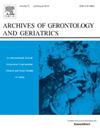Bidirectional longitudinal associations between subjective oral health and subjective well-being
IF 3.5
3区 医学
Q2 GERIATRICS & GERONTOLOGY
引用次数: 0
Abstract
Objective
This study investigated the bidirectional longitudinal association between subjective oral health (SOH) and subjective well-being (SWB) over time.
Methods
This cohort study was based on a four-wave surveys conducted by the English Longitudinal Study of Aging. SOH was measured by oral impacts on daily performance (OIDP), self-rated oral health (SROH), and SWB was measured by the Center for Epidemiologic Studies-Depression (CES-D) scale, Control, Autonomy, Self-Realization, and Pleasure (CASP-19), and satisfaction with life scale (SWLS). To evaluate the bidirectional associations between SOH and SWB, separate models were created using SOH and SWB as the outcome and exposure, respectively. Additionally, the synchronous and lagged effects of exposure on outcomes were checked by employing exposures measured at different time points. A generalized estimating equation model was fitted, including the exposure variables, outcome variables in the previous wave, and baseline covariates.
Results
Among 4,510 participants (mean age=61.7 years [1SD=7.9], men=43.1 %), 8.1 %, 18.2 %, 14.3 %, 30.5 %, and 25.0 % had poor SOH and SWB as measured by OIDP, SROH, CES-D, CASP-19, and SWLS at baseline, respectively. The results of the regression models with all combinations of SOH and SWB measures showed that poor conditions of SOH or SWB were significantly associated with poor conditions of the other measures (all p < 0.05). In almost all combinations of SOH and SWB measures, the synchronous effect was stronger than the lagged effect.
Conclusion
SOH and SWB are closely linked, and comprehensive care that considers oral health could contribute to well-being later in life.
主观口腔健康与主观幸福感之间的双向纵向关联。
目的:研究主观口腔健康(SOH)与主观幸福感(SWB)随时间的双向纵向关系。方法:本队列研究基于英国老龄化纵向研究进行的四波调查。SOH通过口腔对日常表现的影响(OIDP)、自评口腔健康(SROH)来测量,SWB通过流行病学研究中心抑郁(CES-D)量表、控制、自主、自我实现和快乐(CASP-19)和生活满意度量表(SWLS)来测量。为了评估SOH和SWB之间的双向关联,分别以SOH和SWB作为结果和暴露创建了单独的模型。此外,通过使用在不同时间点测量的暴露来检查暴露对结果的同步和滞后效应。拟合了一个广义估计方程模型,包括暴露变量、前一波的结果变量和基线协变量。结果:在4,510名参与者(平均年龄=61.7岁[1SD=7.9],男性= 43.1%)中,基线时OIDP、SROH、ses - d、CASP-19和SWLS测量的SOH和SWB较差的分别为8.1%、18.2%、14.3%、30.5%和25.0%。所有SOH和SWB测量组合的回归模型结果显示,SOH或SWB的不良条件与其他测量的不良条件显著相关(均p < 0.05)。在几乎所有的SOH和SWB测量组合中,同步效应强于滞后效应。结论:口腔健康和口腔健康密切相关,考虑口腔健康的全面护理有助于以后的生活健康。
本文章由计算机程序翻译,如有差异,请以英文原文为准。
求助全文
约1分钟内获得全文
求助全文
来源期刊
CiteScore
7.30
自引率
5.00%
发文量
198
审稿时长
16 days
期刊介绍:
Archives of Gerontology and Geriatrics provides a medium for the publication of papers from the fields of experimental gerontology and clinical and social geriatrics. The principal aim of the journal is to facilitate the exchange of information between specialists in these three fields of gerontological research. Experimental papers dealing with the basic mechanisms of aging at molecular, cellular, tissue or organ levels will be published.
Clinical papers will be accepted if they provide sufficiently new information or are of fundamental importance for the knowledge of human aging. Purely descriptive clinical papers will be accepted only if the results permit further interpretation. Papers dealing with anti-aging pharmacological preparations in humans are welcome. Papers on the social aspects of geriatrics will be accepted if they are of general interest regarding the epidemiology of aging and the efficiency and working methods of the social organizations for the health care of the elderly.

 求助内容:
求助内容: 应助结果提醒方式:
应助结果提醒方式:


